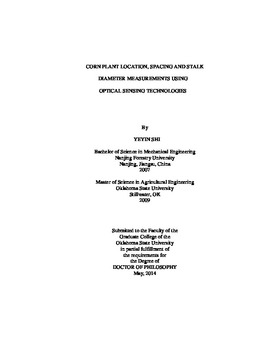| dc.contributor.advisor | Wang, Ning | |
| dc.contributor.author | Shi, Yeyin | |
| dc.date.accessioned | 2015-06-17T20:08:01Z | |
| dc.date.available | 2015-06-17T20:08:01Z | |
| dc.date.issued | 2014-05 | |
| dc.identifier.uri | https://hdl.handle.net/11244/15120 | |
| dc.description.abstract | Plant within-row spacing and stalk diameters at mid-growth stages have been demonstrated to be important variables in the by-plant yield prediction model for corn. This information would help advising the in-season variable-rate fertilizer application to increase the fertilizer use efficiency. Little study could be found in developing an automatic, non-invasive and high spatial resolution system to measure these variables at the desired growth stages. A three-year study was conducted on this topic. The overall goal of this study was to investigate the feasibility of various machine vision technologies and to develop prototype systems for corn plant location, within-row spacing and stalk diameter measurements at their mid-growth stages. | |
| dc.description.abstract | In Phase I and II of this study, a system for plant location and within-row spacing measurements based on the LiDAR technology was developed and improved. In Phase III, a system for plant stalk diameter measurement using two different approaches was developed - the LiDAR-and-RGB Approach was a combination of a LiDAR sensor and a webcam; the 3D Range Imaging Approach used a 3D range camera. In each system, sensors were mounted on a cart and viewing horizontally at the lower sections of plant stalks. These systems featured with their abilities of viewing each plant from multiple angles when the sensors were passed by, which largely increased the possibility of correct identification. At each phase, the system was tested in the field condition. Data processing algorithms were developed to identify potential stalks in a laser scan, a RGB image or a distance image; and to register information between scans or different sensors. | |
| dc.description.abstract | A total error of 5.5% in plant counting and a 1.9 cm of root-mean-squared error (RMSE) in the spacing measurement were achieved between the sensor measurements and the manually measured ground truth for data collected in year 2012. The RMSE of diameter measurement were 4.1 mm and 3.9 mm for the LiDAR-and-RGB Approach and 3D Range Imaging Approach, respectively. This study was a good basis of developing a high spatial resolution corn plant within-row spacing and stalk diameter sensing system for real-time, variable-rate fertilizer application. | |
| dc.format | application/pdf | |
| dc.language | en_US | |
| dc.rights | Copyright is held by the author who has granted the Oklahoma State University Library the non-exclusive right to share this material in its institutional repository. Contact Digital Library Services at lib-dls@okstate.edu or 405-744-9161 for the permission policy on the use, reproduction or distribution of this material. | |
| dc.title | Corn plant location, spacing and stalk diameter measurement using optical sensing technologies | |
| dc.contributor.committeeMember | Taylor, Randal K. | |
| dc.contributor.committeeMember | Weckler, Paul | |
| dc.contributor.committeeMember | Raun, William | |
| osu.filename | SHI_okstate_0664D_13200.pdf | |
| osu.accesstype | Open Access | |
| dc.type.genre | Dissertation | |
| dc.type.material | Text | |
| dc.subject.keywords | by plant sensing | |
| dc.subject.keywords | in-field variability | |
| dc.subject.keywords | machine vision | |
| dc.subject.keywords | population estimate | |
| dc.subject.keywords | variable rate spraying | |
| thesis.degree.discipline | Biosystems and Agricultural Engineering | |
| thesis.degree.grantor | Oklahoma State University | |
